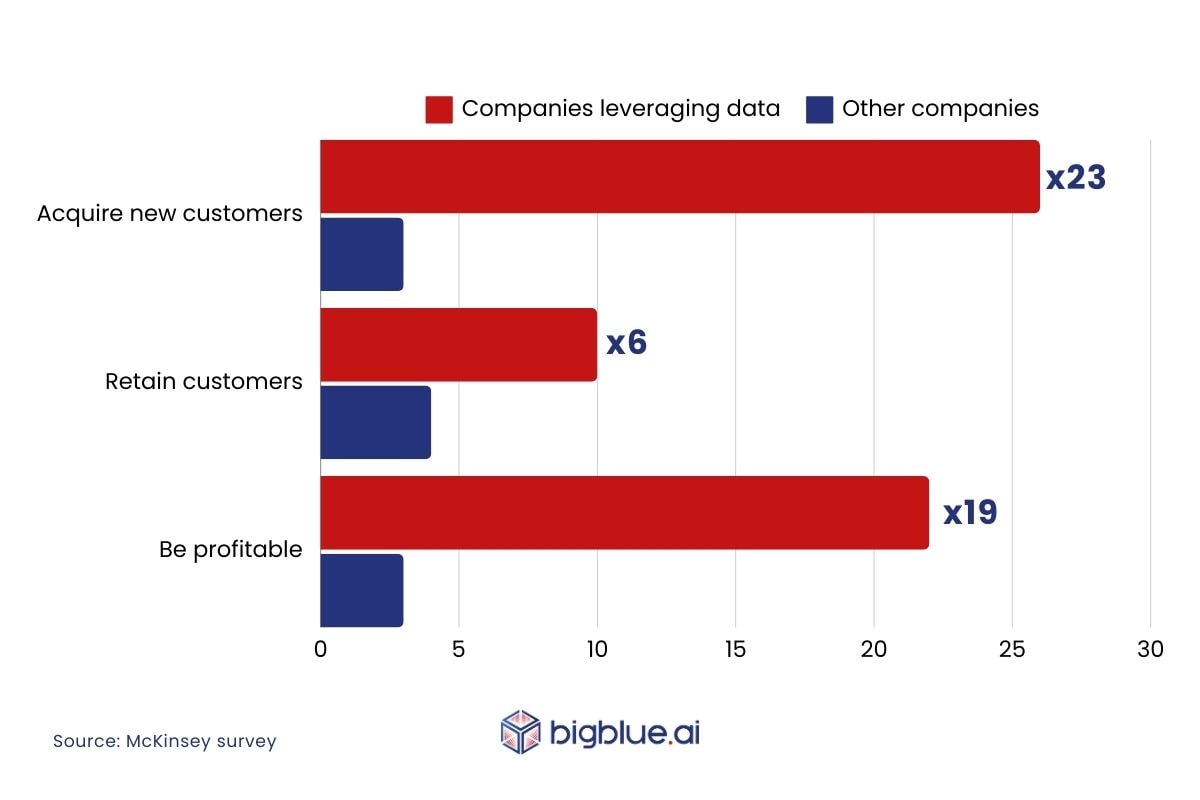Creating a successful data science team involves bringing together a diverse group of specialists, each with unique roles and responsibilities. It’s crucial to understand the importance of different team structures, whether centralized or embedded within specific departments, to ensure alignment with your business objectives. A centralized data science team can offer a unified approach and consistency across the organization, while an embedded structure allows for deeper within departments.
More companies are prioritizing the formation and creating data science teams, integrating them directly into departments like finance or human resources to leverage specialized knowledge. To maximize productivity and impact, fostering clear understanding, coherence, and effective communication among team members is essential.
In fact, a survey by McKinsey found that companies leveraging data science and analytics effectively are 23 times more likely to acquire customers, 6 times as likely to retain customers, and 19 times more likely to be profitable as a result.

Establishing a strong data science team structure is critical for organizations aiming to harness data strategically. The team’s structure plays a pivotal role in its effectiveness, with models like functional and centralized structures offering distinct advantages. A robust data science team encompasses several roles each of them contributes unique skills and responsibilities crucial for achieving the team’s objectives.
#1: Set Clear, Achievable Goals
Align your team's objectives with business priorities to enhance focus and performance. Research has shown that clearly defined goals significantly contribute to team success. According to McKinsey, involving employees in the goal-setting process and linking individual goals to business objectives can greatly improve engagement and performance.(McKinsey & Company) (BetterUp)
When employees understand how their goals fit into the broader company strategy, they are more motivated and productive .
#2: Assign specific roles
Defining data science team roles can lead to a significant increase in productivity. A Deloitte study (Deloitte) on team management indicates that when employees have clear roles, they are more engaged, which directly correlates with higher performance. The clarity reduces role overlap, confusion, and task duplication, leading to better overall team performance.
A data science team typically consists of 6 main roles:
#3: Invest in Continuous Learning and Tools
Investing in continuous learning and the right data science tools is crucial for enhancing employee productivity and innovation. Studies indicate that organizations prioritizing skill development and modern technological resources see significant boosts in performance. For instance, research from LinkedIn Learning highlights that employees engaged in continuous learning are more adaptable to change and better equipped to meet business challenges, ultimately leading to higher productivity and innovation (Whatfix).
Ongoing professional development helps employees stay updated with industry trends and best practices, contributing to better team outcomes and organizational success.
#4: Prioritize Effective Communication
Establish clear communication channels for team cohesion and stakeholder satisfaction. Projects with effective communication practices like using the right data visualization tools are 40% more likely to achieve their intended outcomes. Encourage regular updates, feedback loops, and transparent reporting to keep all parties aligned and informed (PositivePsychology.com) (Vantage Circle).
Testimonial: "The skills I learned led me to build interactive presentations with clear messages and useful information, making meetings more productive. It's very easy to transform simple slides into meaningful visuals and reports that actually mean something to the team." - Effective Data Storytelling training by https://bigblue.ai/
#5: Emphasize Strong Leadership
Cultivate skilled data science managers to guide and empower your data science team. Teams led by effective managers are 20% more likely to meet deadlines and exceed expectations. Strong leaders provide guidance, resolve conflicts, and create an environment where data scientists can thrive (PositivePsychology.com) (BetterUp).
#6: Foster Cross-Functional Collaboration
"Data Science roles are social roles", Dimitris Mousadakos, Big Blue AI CEO.
Encouraging cross-functional collaboration stimulates creativity and accelerates data science project delivery, increasing project completion rates by up to 15% and generating 20% more innovative solutions. When team members from various departments work together on data science projects, they bring unique perspectives that enrich problem-solving and enhance overall performance. Key practices include building shared understanding and purpose, maintaining transparency and open communication, and providing strong leadership. These strategies ensure alignment, reduce misunderstandings, and improve efficiency, leveraging the full potential of diverse teams to drive innovation and achieve strategic goals effectively (CIPD) (McKinsey & Company).
#7: Embrace Adaptability and Agility
Fostering adaptability and agility within your data science team is essential to navigate dynamic business environments effectively. According to a study by McKinsey & Company highlights that organizations with a strong focus on agility can respond more swiftly to market shifts, thus gaining a competitive edge. McKinsey's research indicates that such organizations are not only more resilient but also more innovative, continually evolving to meet emerging demands and overcome obstacles (McKinsey & Company). Furthermore, research from CIPD indicates that agile teams can respond more quickly to market changes, resulting in a 20% improvement in project completion rates and a significant increase in innovative solutions (CIPD).
By implementing these strategies, organizations can build data science teams capable of driving innovation, fostering collaboration, and achieving strategic goals in today’s competitive market. These data science initiatives are crucial for handling different tasks in both small organizations with limited analytics needs and larger entities with more mature programs. Remember, the key to success lies in creating a culture that values continuous learning, clear communication, and data-driven decision-making. Creating the right data science team with this culture is a game-changer and we're passionate about helping companies find the perfect data candidates and develop innovation. If this is the case, reach out to us!